Creating Google calendars (categories)
To use different colors for your events you need to create multiple calendars in Google Calendar (or use the “Proprietary Colors” feature, but it is not recommended). These calendars are used as categories to categorize your events. You can give them useful names like “Home”, “Work”, “Sport”, ...Google’s new “Color Code” function is also supported, please see Event Colors. However please also see “Advantages of multiple calendars” below to see why the new “Color Code” feature isn’t a good choice anyway in most situations.
To create a new calendar please click “Add” under “My calendars” on the left of the Google Calendar website:
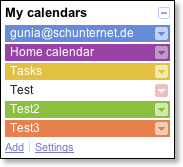
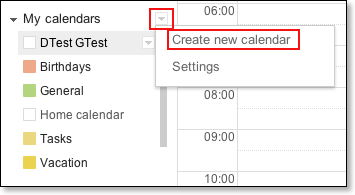
Give the new calendar a name (like “Home”, “Work”, “Sports”) and assign a color to it by clicking the triangle button to the right of its name:

Afterward you have to let CalenGoo know that new calendars were created:
- If you are syncing CalenGoo via the Android calendar, just start the stock calendar app and tap “Menu”, “More”, “My calendars”. Or tap “Settings”, “Visibility/Download” in CalenGoo, open the menu and choose “Refresh Android Calendars”. This will sync the calendar list with Google’s servers. Wait a few seconds until the sync symbol at the top of the screen vanishes. Then return to the calendar view.
- If you are syncing directly with Google Calendar, just tap “Menu”, “Sync” in CalenGoo. It may be necessary to exit and restart CalenGoo to recognize the new calendars.
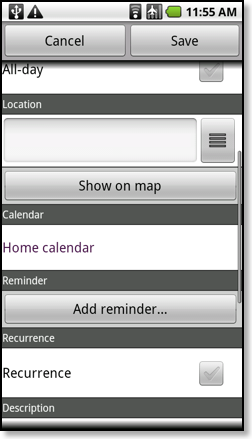
You can change the color of a calendar either in Google Calendar or in CalenGoo (see the next section).
Configuring calendars in CalenGoo
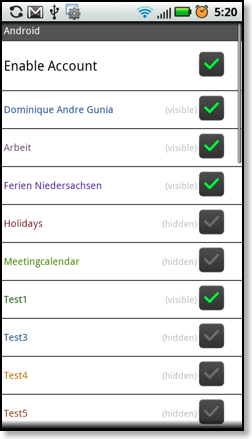
For Android calendars (in the Android and Exchange section), you can choose if they should be “Visible” or “Invisible”. The sync is done automatically by the Android system.
For directly synced Google calendars (in the other sections) you can choose between the following options:
- Download, Google visibility: The calendar is synced, but it is only displayed if it is set to “visible” in Google Calendar, too (during the sync when this information is downloaded). To toggle calendars between visible and invisible in Google Calendar, just click their names on the left side under “My calendars” or “Other calendars”.
- Download, visible: The calendar is always visible and being synced.
- Download, invisible: Syncs the calendar but does not display it. This can be useful e.g. if you don’t have an Internet connection all the time. You can have a current copy of this calendar on your device and make it visible (by setting it to “Download, visible”) even when you are offline.
- No download, invisible: Ignores this calendar.
- No download, visible: This can be useful for holiday calendars: They do not change very often but with the normal configuration they are checked for updates during every sync. Additionally many events in these calendars are often marked as changed due to a problem on Google Calendar’s side. Then CalenGoo has to download them even if they do not contain any real changes. By setting these calendars to “No download, visible” you can skip them during the sync but still display them. This decreases the time needed to sync your calendars. Once in a year you can set them to “Download, visible”, sync and set them back to “No download, visible” to update them.
- Force redownload once, visible: For special circumstances you can set a calendar to this setting to force it to be re-downloaded once during the next sync. Afterward it is set to “Download, visible”.
- Force redownload always, visible: For special circumstances you can set a calendar to this setting to force it to be re-downloaded during every sync.
- Force redownload past week and future events, visible: For special circumstances you can set a calendar to this setting to force it to re-downloaded the past week and all future events during every sync.
To change the color of a calendar, just tap the calendar’s name:

Reordering calendars
If some calendars are more important than others you might want to move them to the top of the list. You can do that by tapping the sort button at the bottom of the "Settings > Visibility/Download" screen. Then use the handle on the right to move your calendars up or down.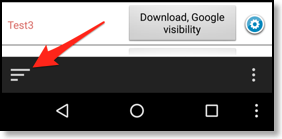
Calendar selection bar
Another useful option is the “Calendar selection bar”: You can turn it on under “Settings”, “Display and Use”, “General”, “Show calendar selection bar”. It displays a list of your calendars at the bottom of the screen and allows you to turn them on or off with a single tap: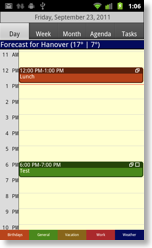
Advanced calendar functions
CalenGoo can have three kinds of calendars: Android calendars, Exchange calendars and directly synced Google calendars. You can see which calendars are used under “Settings”, “Visibility/Download” and you can add additional directly synced accounts under “Settings”, “Accounts”.If you sync CalenGoo with your Android calendar and additionally sync CalenGoo with the same account directly, CalenGoo will display events twice, one copy from the Android calendar and another from the direct sync with Google. To solve this problem disable one of those two calendars under “Settings”, “Visibility/Download” in CalenGoo.
Local calendars
It is possible to use local calendars that exist only in CalenGoo and are not synced with other apps. To use them just turn “Settings”, “Display and Use”, “General”, “Allow local calendars” on. Afterward you can add local calendars under “Settings”, “Visibility/Download”. To change their colors just tap their names in the list under “Settings”, “Visibility/Download” as described above.After creating such local calendars, you can consider to change your default calendar for new events to one of your local calendars. Please see here: Default calendar
You won’t have a backup of your data when you use local calendars and don’t sync your events e.g. with Google Calendar. To reduce the risk of loosing data, you should also turn “Settings”, “Display and Use”, “Maintenance”, “Move DB to SD card” on. Then CalenGoo’s database will be saved on your SD card where it isn’t deleted when CalenGoo is uninstalled. So if your phone is erased and you have to install CalenGoo again, it will find its database on the SD card after the installation and will use it.
But please be aware that other apps on your phone can access CalenGoo’s database if it is saved on the SD card. So moving it to your SD card reduces the risk of loosing data, but another app that has the permission to access your SD card could also access CalenGoo’s database.
If something deletes that file, i.e. CalenGoo’s database “calengoo.sqlite” from your SD card, you data certainly will still be lost. So if your local calendars contains important data, you should create backups of this file at a regular interval, e.g. by using a backup app. CalenGoo also contains an own function to automatically create backups.
Additionally there is a program to create ICS files from this backup file that can be imported e.g. in Google Calendar, please see here: Recover
And if you already have an existing backup as ICS files and would like to import it into a local calendar, you can do that under “Settings”, “Display and Use”, “Maintenance”, “Import calendar from ICS file”.

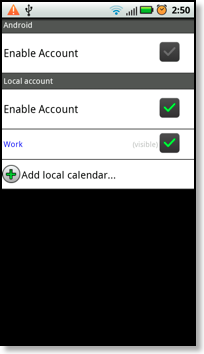

If you are using only local calendars and don’t need or want the Android calendars to sync with Google (e.g. to save battery power) you can turn Android’s sync off. Just start the “Settings” app and tap “Accounts & Sync”, “your account” and uncheck “Sync Calendar”:
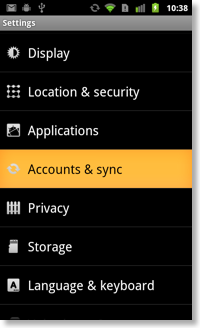
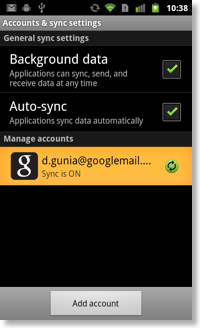
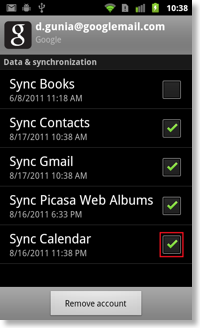
However you shouldn’t save important events into the Android calendars if “Sync Calendar” is turned off, maybe it won’t be reliably saved. If you turned “Sync Calendar” off, you should save your events into the local calendars of CalenGoo.
Advantages of multiple calendars
Google has added a new function to change the color of a single event. Normally events are displayed with the color of their calendar but with this new function they can have a different color than the calendar they belong to. However not using this new function has several advantages:- When using multiple calendars you can give these calendars useful names like “Home”, “Work”, ... These calendars are used as categories. By assigning an event to one of these calendars, you assign it to a certain category. And by its color you can easily see to which category it belong to. E.g. in this screenshot you can easily find your personal events by their blue color and your work events by their red color:
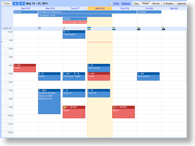
- By separating your events into different calendars/categories you can easily hide some of them that are currently not important: Just click their name on the left to make them visible or invisible. E.g. the screenshot above without the work events would look like this:
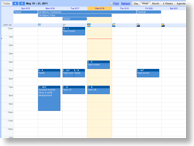
Just click the names on the left to hide/show single calendars/categories:
- You can choose to share certain calendars/categories with other persons without sharing your whole calendar. E.g. you can only share your “Work” calendar/category. So someone else would only see your work events in addition to his own events:
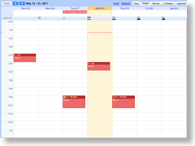
Please see here how to share calendars:
http://www.google.com/support/calendar/bin/answer.py?answer=37082 - You can use CalenGoo’s “Calendar selection bar” (you can turn it on under “Settings”, “Display and Use”, “General”, “Show calendar selection bar” on) that displays a list of your calendars at the bottom of the screen and allows you to turn them on or off with a single tap:






